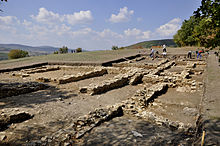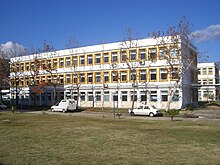This is an old revision of this page, as edited by Cinéma C (talk | contribs) at 19:47, 30 March 2010. The present address (URL) is a permanent link to this revision, which may differ significantly from the current revision.
Revision as of 19:47, 30 March 2010 by Cinéma C (talk | contribs)(diff) ← Previous revision | Latest revision (diff) | Newer revision → (diff)| This article does not cite any sources. Please help improve this article by adding citations to reliable sources. Unsourced material may be challenged and removed. Find sources: "Ulcinj" – news · newspapers · books · scholar · JSTOR (December 2009) (Learn how and when to remove this message) |
| Ulcinj,Ulqin Улцињ | |
|---|---|
 | |
| Coat of arms of Ulcinj,UlqinCoat of arms | |
| Country | |
| Settlements | 39 |
| Government | |
| • Mayor | Gzim Hajdinaga / Gëzim Hajdinaga (DUA) |
| • Ruling party | DUA - DPS - SDP |
| Area | |
| • Total | 255 km (98 sq mi) |
| Population | |
| • Total | 10,828 |
| • Density | 80/km (200/sq mi) |
| • Municipality | 20,290 |
| Time zone | UTC+1 (CET) |
| • Summer (DST) | UTC+2 (CEST) |
| Postal code | 85360 |
| Area code | +382 30 |
| ISO 3166-2 code | ME-20 |
| Car plates | UL |
| Website | www.ulcinj.cg.yu |
Ulcinj (Serbian Cyrillic: Улцињ; Albanian: Ulqin or Ulqini) is a coastal town and municipality in Montenegro. The town of Ulcinj has a population of 10,828 (2003 census) of which the majority are Albanians. Ulcinj is the centre of Ulcinj Municipality and the centre of the Albanian community in Montenegro. This southernmost municipality of Montenegro has a population of 20,290.
History
The wider area of Ulcinj has been inhabited since the Bronze Age, based on dating of Illyrian tombs (tumuli) found in the village of Zogaj, in the vicinity of Ulcinj. The town is believed to have been founded in the 5th century BC by colonists from Colchis, as mentioned in the 3rd century BC poem by Apollonius of Rhodos.
Illyrians lived in the region at the time, and under Greek influence built immense so-called Cyclopean Walls. In 163 BC, the Romans captured Colchinium from the Illyrian tribe of Olciniates and renamed the town Olcinium (aka Ulcinium) after the tribe. Under Roman rule the town received the status of Opidum Civium Romanorum (Town with Special Privileges), only to be later granted Municipium (Independent Town) status. When the Roman Empire was split in two, Olcinium became a part of the Eastern Roman Empire (later known as the Byzantine Empire).
Before the medieval period, Ulcinj was known as one of the pirate capitals of the Adriatic Sea. This is also seen during the later period of Illyrian Kingdom. Inhabitants of Ulcinj were known at the time of Christ, especially from 20 BC to around 300 AD, to be very confrontational to those who were foreigners to their land; they were especially meticulous about border disputes as well.
In 1183, Rascian Grand Duke Stefan Nemanja conquered Olcinium and the town prospered as one of the most significant coastal towns. Ulcinj remained in Nemanjic hands till Emperor Dušan's death in late 1355. In 1356, Lord Balša I, the founder of the Zetan Balšić dynasty, was granted parts of former Dioclean territory, including Ulcinj, by Emperor Dušan's son and successor, Emperor Uros VI, and broke away from the Serbian Empire, only to establish an independent lordship called Zeta. Under Balšić's control, Ulcinj served as a popular resort, as well as a mint.
The Republic of Venice captured Ulcinj from Balša III of the Zetan Balšić dynasty in 1423. Under Venetian control, the city was renamed Dulcigno in the Venetian language, and it was incorporated in the Albania Veneta. A shipwreck of a Saracen ship occurred on the shores of Ulcinj with stranded African slaves; locals saved the surviving Africans and made them an integral part of the population of the town.
The Venetians maintained control until 1571, when the Ottoman Turks conquered Dulcigno and the remainder of Albania Veneta. In 1867, Ulcinj became a kaza of the İşkodra sanjak of Rumeli veyalet. Ulcinj finally gained its independence from the Turks on 11 January 1878 by the decision of the Berlin Congress (see Treaty of Berlin (1878)), only to be fully integrated into Montenegro nearly three years later, on 30 November 1880.
Famous Inhabitants
Population

Ulcinj is administrative centre of Ulcinj municipality, which has 20,290 residents. The town of Ulcinj itself has a population of 10,828.
Ulcinj is the centre of the Albanian community in Montenegro. It is the only municipality in Montenegro where Albanians form the overwhelming majority.
There is a small community of "Black Montenegrins" whom are thought to be descendants of Turks, other theories are a group of Balkan Egyptians or Roma people adapted a different identity over time, and mixed race of Albanians, transplanted North Africans and/or local Slavs.
Population of Ulcinj:
- March 3, 1981 - 9,140
- March 3, 1991 - 10,025
- November 1, 2003 - 10,828
Ethnic groups (2003 census):
- Albanians (73.14%)
- Montenegrins (11.93%)
- Serbs (7.44%)
- Muslims by nationality (3.36%)
- Bosniaks (1.46%)
Religion (2003 census):
- Muslims (70%)
- Orthodox (10%)
- Roman Catholic (20%)
Tourism

The Ulcinj "south coast" region of Montenegro is a popular tourist destination. In January 2010, The New York Times ranked the south coast region of Montenegro, featuring Velika Plaza, Ada Bojana, and the Hotel Mediteran, as among "The Top 31 Places to Go in 2010" The citation was part of a worldwide ranking of travel destinations.
The summer time in particular, is a popular time for visitors to Ulcinj. Although still undiscovered by many travelers from larger countries, repeat tourists and an increasing amount of first time visitors make Ulcinj a hot spot for vacationers between the months of May and September. It is most famous for its beaches, which are considered the most beautiful in Montenegro. The most valuable resource of the Ulcinj riviera is Velika Plaza / Plazha e Madhe (literally "Big Beach"), which is a 12 km (7.5 mi) long portion of sandy beach - the longest on the Montenegrin coast. There is also a beach that holds the name Mala Plaža ("Plazha Vogel") which is much smaller in size, but is very popular with visitors. "The Korzo" as it is called by locals, is a strip-like walkway ligning the small beach. At night during the summer months, young tourists walk past one another while bright lights decorate the street and live music invades their ear drums. It is said that some of the most beautiful girls in South Eastern Europe, visiting Ulcinj as tourists, can be found walking about the Korzo on a nightly basis. There are many more less known smaller beaches that serve as a get-away to many people looking to catch their breath.

Ulcinj's old town is a very well preserved castle-looking community that is left over from medieval times. The old town sits atop a mountain overlooking the shore and is a tourist attraction on its own.
Ada Bojana(Albanian Buna) is popular among foreign tourists from Western Europe for its peace and unique atmosphere.
Lake Skadar, also known as Šaško lake, and Ulcinj's salt pond are popular among birdwatchers, because Ulcinj and its surroundings are major resting points for over 200 bird species on their migration paths.
There are numerous pubs, dance clubs, and bars that dot the city that are usually filled to capacity throughout the summer.
The majority of tourists in Ulcinj are Albanians, Germans, Italians, and Eastern Europeans. A large number of Americans who are either of Albanian descent or were born in or near the city of Ulcinj often make the city a prime summer time destination.
The sandy beaches Ultsinya, approximately 17 kilometers long, have become a trademark of Montenegro's southern coast. However, few tourists know that in these places there is a shoreline area called Ladies Beach . In a small pebble bay, hidden by rocks, for more than a century women have come for infertility treatment.
Sports and Recreation
The Ulcinj "south coast" region is well-known for its active sports and recreation possibilities. Kitesurfing at Ada Bojana, all manner of water sports at Velika Plaza, scuba diving among wrecks and sunken cities, mountain biking, hiking, orienteering, cycling through the olive groves at Valdanos, long walks along the pristine beaches of the south coast of Montenegro, even deep sea fishing on the Adriatic, lake fishing at Lake Skadar, and river fishing in Ada Bojana, are among the many possibilities for visitors interested in more active holiday pursuits.
Climate
Ulcinj has a Mediterranean climate, with cool rainy winters and hot dry summers. Unlike Podgorica temperatures very rarely exceed 35°C and seldom drop below 0°C.
| Climate data for Ulcinj, Montenegro | |||||||||||||
|---|---|---|---|---|---|---|---|---|---|---|---|---|---|
| Month | Jan | Feb | Mar | Apr | May | Jun | Jul | Aug | Sep | Oct | Nov | Dec | Year |
| Source: weather2travel.com | |||||||||||||
Transport

Ulcinj is connected with the rest of Montenegro by two-lane highways. It is connected with other coastal towns by the Adriatic Motorway. Reaching inland is made possible by detouring from The Adriatic Motorway at Budva or Sutomore (through Sozina tunnel).
As of today, there are no airports in the city of Ulcinj. However, nearby airports in Tivat and Podgorica are both around 70 km (43 mi) away. There are regular flights to Belgrade and Zurich from Tivat. Podgorica Airport has regular flights to major European destinations throughout the year. Many tourists traveling to Ulcinj from abroad arrive to the city from the airport in Tivat due to its recent renovations and general ease of navigation.
Within the city, public transportation is available to the general public by way of city buses. Along with private automobiles, taxi cabs and vans (KOMBI) are in great abundance throughout the city and its vicinities. To avoid congestion in the often traffic-laden streets of Ulcinj, many young locals opt for travel by motorbike and scooter, which are also available for rent on a daily or weekly basis.
See also
External links
- The New York Times, "The 31 Places to Go in 2010"
- Ulcinj Commune site
- Visit Ulcinj City Guide
- Ulcinj South Coast regional travel portal
- Hotel Mediteran Ulcinj
 Chisholm, Hugh, ed. (1911). Encyclopædia Britannica (11th ed.). Cambridge University Press.
Chisholm, Hugh, ed. (1911). Encyclopædia Britannica (11th ed.). Cambridge University Press. {{cite encyclopedia}}: Missing or empty|title=(help)